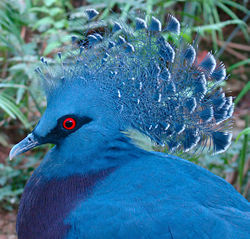| Columbea Temporal range: [1] | |
|---|---|
 | |
| Victoria crowned pigeon ( Goura victoria ) | |
 | |
| Black-necked Grebe ( Podiceps nigricollis ) | |
| Scientific classification | |
| Domain: | Eukaryota |
| Kingdom: | Animalia |
| Phylum: | Chordata |
| Class: | Aves |
| Infraclass: | Neognathae |
| Clade: | Neoaves |
| (unranked): | Columbea Jarvis et al., 2014 |
| Clades | |
Columbea is a clade suggested by genome analysis that contains Columbiformes (pigeons and doves), Pteroclidae (sandgrouse), Mesitornithidae (mesites) and Mirandornithes (flamingos and grebes). [2] Until their recent placement as the sister taxon to Passerea, in the last decade various genetic analysis found them to be in the obsolete clade Metaves. [3] [4]
| Columbea |
| ||||||||||||||||||||||||
